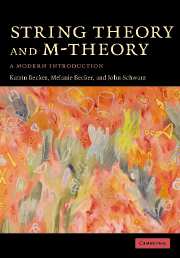Book contents
- Frontmatter
- Contents
- Preface
- 1 Introduction
- 2 The bosonic string
- 3 Conformal field theory and string interactions
- 4 Strings with world-sheet supersymmetry
- 5 Strings with space-time supersymmetry
- 6 T-duality and D-branes
- 7 The heterotic string
- 8 M-theory and string duality
- 9 String geometry
- 10 Flux compactifications
- 11 Black holes in string theory
- 12 Gauge theory/string theory dualities
- Bibliographic discussion
- Bibliography
- Index
12 - Gauge theory/string theory dualities
Published online by Cambridge University Press: 05 September 2012
- Frontmatter
- Contents
- Preface
- 1 Introduction
- 2 The bosonic string
- 3 Conformal field theory and string interactions
- 4 Strings with world-sheet supersymmetry
- 5 Strings with space-time supersymmetry
- 6 T-duality and D-branes
- 7 The heterotic string
- 8 M-theory and string duality
- 9 String geometry
- 10 Flux compactifications
- 11 Black holes in string theory
- 12 Gauge theory/string theory dualities
- Bibliographic discussion
- Bibliography
- Index
Summary
Many remarkable dualities relating string theories and M-theory have been described in previous chapters. However, this is far from the whole story. There is an entirely new class of dualities that relates conventional (non-gravitational) quantum field theories to string theories and M-theory.
There are three main areas in which such a gauge theory/string theory duality emerged around the mid to late 1990s that are described in this chapter:
Matrix theory
Anti-de Sitter/conformal field theory (AdS/CFT) correspondence
Geometric transitions
Historically, string theory was introduced in the 1960s to describe hadrons (particles made of quarks and gluons that experience strong interactions). Strings would bind quarks and anti-quarks together to build a meson, as depicted in Fig. 12.1 or three quarks to make a baryon. As this approach was developed, it gradually became clear that critical string theory requires the presence of a spin 2 particle in the string's spectrum. This ruled out critical string theory as a theory of hadrons, but it led to string theory becoming a candidate for a quantum theory of gravity. Also, QCD emerged as the theory of the strong interaction. The idea that there should be some other string theory that gives a dual description of QCD was still widely held, but it was unclear how to construct it. Given this history, the discovery of the dualities described in this chapter is quite surprising.
- Type
- Chapter
- Information
- String Theory and M-TheoryA Modern Introduction, pp. 610 - 689Publisher: Cambridge University PressPrint publication year: 2006

